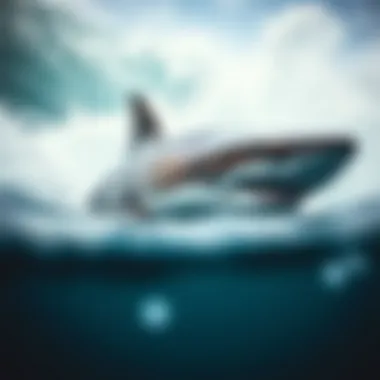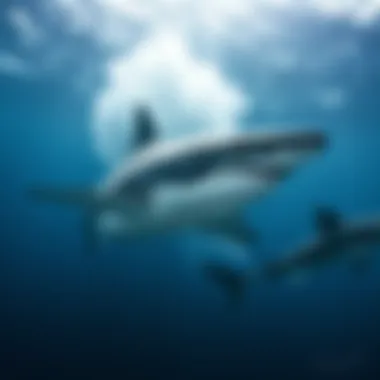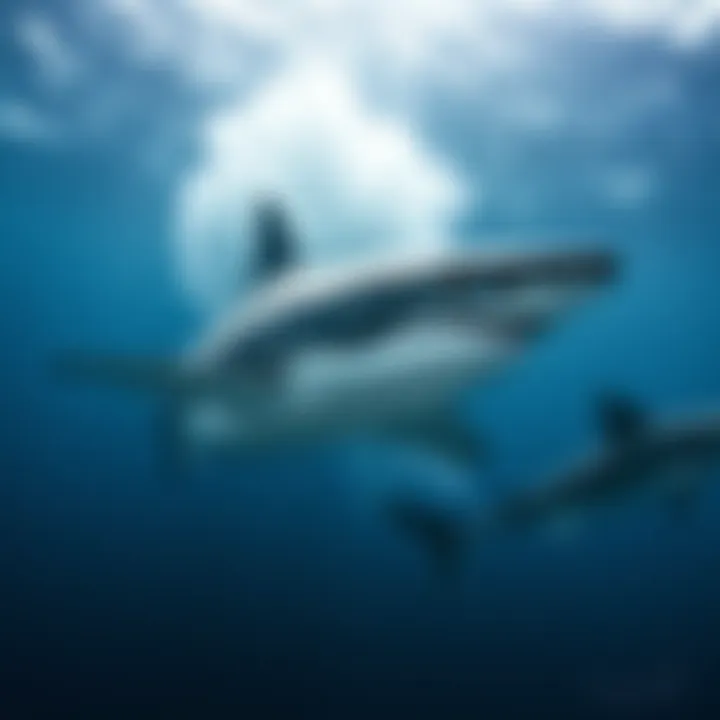Fascinating Shark Facts: Beyond the Surface


Intro
Sharks, with their sleek bodies and razor-sharp teeth, often evoke a mix of fear and fascination. Yet, these remarkable creatures are much more than the mindless predators they are sometimes made out to be. Beneath the surface of their formidable exterior lies a world rich in peculiar behaviors and quirky traits that many people are blissfully unaware of. This article aims to shed light on those aspects of sharks that often get overshadowed by sensationalized media portrayals, diving deep into their biology and peculiar interactions with humans.
With an ever-expanding array of research highlighting unique shark behaviors, an understanding of these creatures is essential not only for marine biologists or ecologists but for anyone who loves the ocean, including surfers, travelers, and outdoor enthusiasts. Through a blend of insights and unusual facts, we explore how sharks contribute significantly to ocean ecosystems and why their conservation should matter to us all.
From their strange hunting techniques to unusual social structures, sharks engage with their environment in ways that can be both curious and unbelievable. Let’s dive deeper, challenging the stereotypes and misconceptions, while stoking the appreciation for these extraordinary ocean dwellers.
Gear and Equipment
Unconventional Tools for Shark Encounters
When heading out to the ocean, understanding the gear that surfers may use not just for riding the waves but for ensuring safe encounters with sharks is paramount. While many embrace surfboards as their primary tool, it’s essential to consider the equipment that keeps them safe and educated.
- Shark Deterrents: New technologies such as electronic shark deterrents, which emit a field that disrupts the electrical senses of sharks, are advancing rapidly. Such devices can be a game changer for surfers wanting to enjoy the waves without the looming fear of unexpected encounters.
- Diving Watches: High precision diving watches that track underwater activity and time can be considered vital pieces of gear. They often come with integrated diving profiles, aiding surfers in understanding the exact depth and conditions they may face in unfamiliar waters.
- Board Leashes with Safety Features: Some leashes are designed with reflective materials or colors that can help spot surfers’ boards in cloudy or murky waters. Keeping your equipment visible can potentially reduce unwanted encounters.
Surfing gear isn't solely about comfort on the waves. Safety equipment becomes increasingly important when sharks are in proximity. In the rush of surfing, being prepared can make all the difference.
Must-Have Accessories for Ocean Activities
Alongside essential surfboards, a list of accessories can further enhance safety and experience:
- Wetsuits: A quality wetsuit not only keeps surfers warm but can also help with buoyancy, making it easier to stay afloat if necessary.
- Shark Shields: Portable devices that can be employed when entering the water to offer peace of mind.
- Educational Materials: Quick reference guides about local shark species and their behaviors can empower surfers with knowledge before they hit the waves.
Equipping oneself with the right gear goes beyond the practical. Knowledge intertwines with equipment to forge a safe and enriched connection to the ocean.
"The ocean stirs the heart, inspires the imagination and brings eternal joy to the soul." - Wyland
Final Thoughts on Gear
Getting familiarized with the peculiarities of sharks and the tools that support safe engagement with these creatures can be fulfilling. Taking a proactive approach to understanding your surroundings and utilizing innovative equipment not only enhances the surfing experience but also encourages a culture of respect for marine life. More than just surfers, we are also stewards of the ocean.
As we venture into the next segments of this endeavor, we will explore how sharks interact uniquely with their environments and various flavors of shark behaviors that defy popular belief.
Understanding Sharks
Sharks are more than just prominent figures in coastal waters; they are a vital part of marine ecosystems. Understanding sharks involves digging into their complex biology, diverse species, and varied interactions with their environment. This knowledge not only broadens our perspective but also highlights the importance of conserving these majestic creatures that have roamed our oceans for hundreds of millions of years. By educating ourselves about sharks, we can dispel myths and misplaced fears, emphasizing their role as apex predators that help maintain the balance of oceanic life.
Classification and Species Diversity
The Great White: Not Just a Movie Star
The Great White shark, often dubbed the apex predator of the sea, is fascinating for more reasons than just its Hollywood fame. With the ability to grow over 20 feet long and weigh more than 5,000 pounds, this species has a unique physiology slightly adapted for hunting large marine mammals. Their robust bodies, coupled with a keen sense of smell and an acute ability to detect electromagnetic fields, make them formidable hunters.
The Great White’s role in maintaining marine ecosystem health is significant. When it preys on seals or sea lions, it helps control those populations, which in turn ensures that resources are sustainably utilized within the oceanic environment. Understanding its behavior helps dispel fears perpetuated by media portrayals, casting them instead as essential players in the intricate web of ocean life.
Tiny Sharks: The Underrated Species
Not all sharks boast intimidating sizes; tiny species like the dwarf lantern shark, measuring about 8 inches long, are just as fascinating. These small sharks, often found in deep waters, possess bioluminescent properties, using their ability to glow in the dark as a means of camouflage from predators and to attract prey.
While they might not capture the limelight as their larger counterparts do, the ecological contributions of these minuscule sharks are noteworthy. Their existence showcases biodiversity's importance, reminding us that each species has a unique role, even if it's not out in the spotlight. Learning about them fosters an appreciation for lesser-known species that contribute greatly to the health and balance of their habitats.
Shark Sizes: From Miniature to Mighty
Sharks come in all sizes, from the minuscule dwarf lantern shark to the massive whale shark. This vast range not only highlights the adaptability of the species but also underscores the variations in their ecological niches. The whale shark, for instance, is the largest fish in the ocean, growing up to 40 feet in length. Unlike many of its predatory kin, the whale shark is a filter feeder, primarily munching on plankton and small fish.
The perception of sharks is often hindered by the fear of giant predators lurking beneath the waves. However, recognizing the diversity in size and feeding habits aids in debunking stereotypes. It’s vital that we understand this variety when discussing shark conservation efforts, as different sizes imply different ecological roles and necessitate tailored protection strategies.


Shark Anatomy: Nature's Engineering
Teeth: An Ever-Changing Arsenal
Shark teeth are worth discussing not merely for their sharpness but for the impressive adaptability they showcase. Unlike humans, sharks possess several rows of teeth that are constantly replaced throughout their lives—sometimes thousands of times. This continuous renewal provides them with the necessary tools to tackle diverse prey, ensuring their survival in various environments.
Their teeth vary in shape and size depending on their dietary needs—some, like the Great White, have serrated edges for tearing flesh, while others, like the filter-feeding whale shark, have more brush-like forms appropriate for consuming plankton. By examining these features, we gain insights into their predatory efficiencies and evolution, emphasizing how nature engineers solutions that suit each species’ lifestyle.
Skin: The Armor of Sharks
Shark skin, remarkable in its composition, is another testament to nature’s craftsmanship. Covered in tiny, denticle-like structures called dermal denticles, their skin is not only tough but also reduces drag when swimming, enhancing their stealthy approach to prey. This innovative design exemplifies evolutionary adaptation to their predatory lifestyle.
Moreover, the skin also plays a role in protection; its rough texture deters parasites and other external threats. Understanding shark skin can shed light on potential applications in biomimicry, influencing designs in high-performance materials across various industries.
Senses: Beyond Human Perception
A shark’s senses are extraordinary, making them supremely equipped for life underwater. Their ability to detect minute changes in water pressure, their keen sense of smell, and the extraordinary capability to perceive electrical signals in the water are crucial for hunting.
Sharks can detect a single drop of blood in an Olympic-sized swimming pool, a testament to their remarkable olfactory abilities. Understanding these senses helps us appreciate their hunting strategies and spot their potential threats in the wild. Exploring how these sensory abilities evolved can enlighten us about their survival tactics and remind us of the wonders of marine biology.
Humor in Shark Biology
When people think of sharks, they often conjure images of ferocious predators lurking just beneath the surface. Yet there’s a side to these magnificent creatures that’s worth a chuckle or two, providing light-hearted insights that illuminate how versatile and adaptive they truly are. The inclusion of humorous elements in the study of shark biology not only highlights the quirks and oddities of these animals but also serves to break down misconceptions that often paint them in a solely menacing light. By exploring their sometimes bizarre reproductive habits and feeding behaviors, we can appreciate sharks as dynamic beings that contribute richly to the tapestry of marine life.
Bizarre Reproductive Strategies
Viviparity vs Oviparity: An Unexpected Twist
Viviparity and oviparity present a fascinating contrast in shark reproduction. Viviparous sharks, such as the hammerhead, give live birth. On the flip side, oviparous species, like the blacktip reef shark, lay eggs. Despite this seeming divergence, both strategies contribute to the overall resilience of shark populations.
One of the intriguing features of viviparity is the ability for the embryos to develop internally, offering them protection from predators. Meanwhile, the eggs of oviparous sharks are often tucked away in safe havens, with some species even using unique strategies to camouflage their egg cases, ensuring their offspring start life with a fighting chance. Each approach has advantages, depending on environmental conditions. If you think about it, it’s funny that sharks can be both protective parents and stealthy egg-layers all in one evolutionary breath!
Parthenogenesis: The Unusual Asexual Method
Parthenogenesis, a fancy term for asexual reproduction, might sound like something out of a sci-fi movie, but it’s a reality for some sharks, like the bonnethead. In this method, females can create offspring without male fertilization, which is an interesting twist when you consider the sharks' predatory nature.
The beauty of parthenogenesis is that it enables a shark to proliferate even in environments where mates are scarce. However, it’s not without its downsides. Since genetic diversity suffers, it could lead to reduced adaptability among populations. Still, it’s a rare peek into nature’s oddball strategies that makes one ponder about the lengths these creatures will go to ensure their species survive.
Shark Courtship: A Dance of Survival
Then there’s the courtship behavior of sharks, which some might see as more of a wrestling match than a romantic evening. The courtship process for sharks is often a perilous dance. For many species, males will grab onto females with their teeth, which sounds more like a wrestling match than a tender exchange.
This behavior highlights the struggle for survival, where only the strongest and most adept participate in the mating ritual. The irony of sharks displaying such aggressive behaviors when securing their partnerships only adds to the humor of their reproductive strategies. The spectacle can be both brutal and comical, underscoring the theater of life beneath the waves.
Unusual Feeding Habits
Filter-Feeding Sharks: Nature's Cleanup Crew
Just when you think you’ve figured out what a shark eats, enter filter-feeding sharks like the basking shark, which are gentle giants. Instead of chomping down on prey with a ferocity, they glide through the water, filtering out plankton. This behavior highlights the diversity of feeding strategies among sharks and their adaptability to different ecological niches.
The unique characteristic of filter-feeders is their massive gill rakers that allow them to collect their minuscule food source. Not only does this make them nature's cleanup crew, but it also adds a humorous twist to the idea that all sharks are relentless hunters. They remind us that even within their fierce demeanor, there exists a peaceful, almost humorous side as they gracefully cruise the oceans.
Stomach Content: The Surprising Diet of Sharks
You might think that all sharks have the same appetite, but you’d be quite surprised. Their stomach contents can range from fish and squid to even unexpected items like license plates or old shoes! This eclectic diet reveals the reality that sharks aren’t as picky as we might imagine.
Understanding what sharks eat can give insights into their adaptability and the ecosystem's health. It’s almost ironic that these sophisticated hunters can also be seen munching on discarded human artifacts. It’s a funny way to remind us that what we dispose of can have unintended consequences in the animal kingdom.
Prey Selection: Who Says Sharks are Picky?


While many people think sharks only crave the meat of larger fish, the truth is a tad different. Research illustrates that some sharks are opportunistic eaters. It begs the question: Are they really picky, or do they eat whatever is on the menu?
Many species adapt their feeding patterns based on what's available. From small fish to unexpected finds, these creatures show how flexible they really are. The reality is, the more we learn about their prey selection, the more we see them as adaptive and resourceful.
In summary, the humorous aspects of shark biology shed light on some intriguing and unique behaviors that often go unseen beneath the wave. From reproduction to feeding habits, these insights help us appreciate sharks not just as predators, but as complex beings that navigate their environments with surprising wit and charm, contributing to a diverse and balanced marine ecosystem.
World of Sharks: Interactions with Humans
The relationship between sharks and humans is a complex saga of fear, misunderstanding, and fascination. When we peel back the layers, we discover that interactions with these magnificent creatures extend far beyond the occasional headlines about shark attacks. This topic is essential as it brings to light the nuances of this relationship, providing insight into how pop culture shapes our views, its implications for conservation, and the underlying truths about these apex predators. Understanding our interactions with sharks leads us to a more informed perspective on marine ecosystems, emphasizing the necessity of shark conservation efforts. We’ll delve deep into the various facets of this relationship, from common misconceptions about shark attacks to cultural representations and pressing conservation issues.
Shark Attacks: The Statistics Behind Fear
Common Misconceptions About Attacks
Misconceptions about shark attacks abound, engendering an irrational fear in seaside communities and surf enthusiasts alike. The popular image of a lurking predator waiting for the opportune moment to strike is not only oversimplified but also misleading. In fact, statistics reveal that the risk of unprovoked shark attacks is astronomically low. For instance, in the United States, you're more likely to get struck by lightning or bitten by a dog than to have a negative encounter with a shark.
This dominant narrative around shark attacks contributes to their portrayal as mindless killing machines. Understanding these misconceptions is beneficial, not just for fostering respect for these creatures but also for informed decision making around marine activities. The unique facet of these misconceptions is that they are often rooted in sensationalized media reports, which can skew public perception and further feed into the cycle of fear.
Shark Behavior Before an Attack
The behavior of sharks prior to an attack is another area rife with myths and misunderstandings. Sharks do display specific behaviors when they feel threatened or are preparing to attack, which can include erratic swimming patterns. However, categorizing their pre-attack behavior as calculated hunting tactics paints a misleading picture. This can be particularly useful to know for both safety and appreciation of shark behavior.
Being aware of these behaviors allows humans to understand sharks on their terms. People engaged in activities such as surfing can benefit from knowing these signs, which may enable safer enjoyment of ocean waters. Understanding their behavior could also help eliminate unnecessary panic and furtive avoidance of these wondrous creatures.
Survivors: The Stories Behind Statistics
The personal narratives of shark attack survivors can provide crucial context to raw statistics. Each story sheds light on the complexities of human-shark interactions and often reveals that survivors did not view their encounters through the lens of sheer terror afterwards. Instead, many become advocates for shark conservation, emphasizing that these incidents, while traumatic, mustn't overshadow the larger imperative to protect sharks.
By sharing these firsthand accounts, we can shift the narrative from fear to awareness and conservation. Survivor stories can highlight how quickly misunderstandings can occur in our ocean interactions, allowing room for a more compassionate stance toward sharks.
Shark Conservation: Humor in the Serious
Shark Finning: A Disheartening Industry
The practice known as shark finning is nothing short of tragic for both sharks and ocean ecology. Fishermen typically catch sharks, remove their fins, and then throw the rest of the helpless, often still living, creature back into the ocean to die. It's a gruesome industry driven by demand for shark fin soup, particularly in Asian markets, which is viewed as a delicacy. This activity, many would argue, is emblematic of a disconnect between consumer habits and ecological awareness.
Highlighting shark finning in the context of this article not only brings a serious issue to discussion but also underlines its absurdity—consuming the fins while disregarding the rest of the fish makes little sense. It’s a call for a more profound shift in thinking about ocean resources among consumers. By addressing the darker side of the industry with humor and irony, we can encourage more dialogue about the serious need for conservation.
Human Intervention: The Comic Reality
Humans often intervene in shark habitats in ways that are both well-meaning and misguided. From excessive tourism to fishing, our direct actions impact shark populations. However, some interventions come with unexpected consequences that might make one chuckle—like when people claim they are ‘saving’ sharks by setting up social media pages dedicated to them, yet they contribute to the very activities that threaten them.
Discussing these interventions humorously allows for a critical look at conservation efforts. Many interventions are well-intended but poorly executed. To bring about genuine change, we have to acknowledge the irony that sometimes we find ourselves playing the role of savior on one platform while harming these creatures on another.
Symbols in Culture: Sharks as Icons
Sharks are ingrained in our culture, often represented as symbols of danger and adventure. Films like "Jaws" have solidified their representation as fearsome predators, but sharks also symbolize freedom, strength, and resilience. Understanding how sharks fit into societal symbols offers profound insights into our cultural psyche and values.
This topic is both beneficial and popular within this article. In dissecting how sharks are portrayed in various media, we can begin to unravel the complexities of our emotions tied to them. Whether as boogeymen in horror flicks or protectors of the reef, sharks serve multifaceted roles, allowing us to reflect on our relationship with nature and the ocean itself. Their representation offers opportunities to educate and redirect conversations toward conservation.
The interplay between humans and sharks is filled with nuances that are both interesting and complex. By engaging with these different aspects, from misconceptions to cultural symbols, we can foster a better understanding and appreciation for these extraordinary creatures in marine ecosystems.
Interesting Shark Facts
Understanding sharks extends beyond mere intimidation and fear. The facts highlighted in this section are crucial for dispelling myths and showcasing the complexities of these magnificent creatures. From their astonishing longevity to their intricate methods of communication, these characteristics not only deepen our appreciation for sharks but also emphasize their essential role in maintaining the health of marine ecosystems. By delving into these unique aspects, we can foster a greater respect for their existence and the necessity of their preservation.
The Oldest Living Species


The Greenland Shark: Aged to Perfection
The Greenland shark, known for its impressive longevity, can live for hundreds of years, making it one of the oldest living vertebrates on the planet. Recent studies have suggested that these sharks may reach ages of over 400 years! This remarkable lifespan helps researchers understand environmental changes and the long-term impacts of climate change. The unique characteristic of the Greenland shark is its ability to survive in Arctic waters, adapting to extreme cold and low light conditions. Its slow growth rate, often linked to its long lifespan, can serve as a vital indicator of ecological shifts happening in the ocean.
Longevity and Myths of Age
Debunking myths surrounding the age of sharks is essential, as these misconceptions can skew public perception and conservation efforts. Many think sharks live significantly shorter lives, but the reality is strikingly different when you look closely. The Greenland shark’s age can be misleading. Scientists utilize radiocarbon dating of eye lenses to determine age, revealing that many shark species can live longer than previously believed. This factor creates exciting opportunities but also challenges for researchers studying how these long-living creatures contribute to their environments over decades or centuries.
Growing Old: Shark Species Comparisons
This section provides an interesting exploration of lifespan differences among shark species. For instance, while the Greenland shark tops the longevity charts, other sharks, like the tiger and great white, typically live around 20 to 30 years. Analyzing how age impacts behavior, reproduction, and ecological roles can enhance our understanding of shark populations. Each species shows unique adaptations and characteristics that highlight the resilience of sharks in various environments.
Shark Communication: Sounds and Signals
Vocalizations: Misunderstandings and Facts
Sharks have long been mistakenly considered mute creatures. In reality, many species communicate through a set of vocalizations often associated with their hunting tactics or social interactions. When in packs, some sharks can produce low-frequency sounds that convey distress or alert others to potential threats. Understanding these vocalizations—although still a work in progress—opens up new avenues for research and fosters a deeper connection between humans and these animals, creating an important dialogue about their conservation.
Body Language: A Silent Language
Sharks are great communicators, even without making a sound. Much of their interaction takes place through body postures and movements. The way they swim, their position relative to each other, and how they show aggression or submission can say a lot. For example, a shark that swims slowly with its fins spread may be indicating calmness, whereas rapid movements or aggressive swimming tactics can signal threat or hunting behavior. Understanding these non-verbal cues enriches the discourse on shark behavior and opens the door to more accurate assessments of their reactions to human activity and environmental changes.
Environmental Responses: Communicating with the Ocean
Sharks are incredibly attuned to their environment, using sensory adaptations to gather information about their surroundings. They respond to changes in water pressure, temperature, and even chemical signals released by other marine creatures. This nuanced communication allows them to navigate their habitats, find prey, and avoid dangers.
In essence, sharks exhibit a form of communication that is both sophisticated and profound, yet remains largely underrated and underexplored.
By recognizing these details, we gain insights that not only reveal shark behavior but also inform conservation strategies, ensuring these essential players in ocean ecosystems can thrive for generations to come.
For further information on shark communication methods, visit Wikipedia or check scientific papers from Britannica.
Cultural Representation of Sharks
Exploring the cultural representation of sharks is vital in understanding how society perceives these incredible creatures. This section sheds light on how sharks are portrayed in various media, merchandises, and even in legends. It also highlights the discrepancies between their portrayal and their actual behaviors. An exploration of cultural representation shows its influence on popular beliefs about sharks, significantly shaping our understanding and attitude towards them. Without a doubt, highlighting these aspects elevates our discussion about sharks, encouraging readers to reassess their preconceived notions.
Sharks in Media: Fiction vs Reality
Films: Iconic but Misleading
Shark-themed films often have the power to draw large audiences, but they also distort the real nature of these animals. Movies like Jaws create a dramatic representation of sharks as ferocious killers, which is far from the truth. The portrayal tends to evoke fear, overshadowing the essential ecological role sharks play. This sensationalism makes captivating viewing but does a disservice by fueling misconceptions.
Films highlight the thrill of danger without addressing the fact that shark attacks are rare. While these stories thrive on adrenaline, exploring the factual side provides a more balanced narrative. This is beneficial for readers to understand that the real nature of sharks is not about hunting humans, but rather about their role in maintaining healthy ocean ecosystems.
Literature: Sharks in Folklore
In folklore, sharks often take on mythical qualities. Various cultures integrate shark legends into their storytelling, weaving tales of bravery or treachery. For example, in Hawaiian culture, sharks are revered as sacred guardians. These narratives elevate sharks from mere predators to symbols laden with cultural significance. The unique feature of folklore is its ability to nurture respect for these creatures, showcasing them as powerful yet enigmatic beings. In this article, discussing these stories highlights how they can foster an appreciation for sharks that transcends fear, transforming them into cherished figures in human culture.
Documentaries: Bridging Gaps in Perception
Documentaries serve as a bridge to understanding the truth about sharks. They depict sharks in their natural habitats, emphasizing their behaviors and interactions in ways that films often fail to do. Quality documentaries provide a detailed, fact-based perspective that challenges fear-based assumptions often perpetuated in popular media. A key characteristic of these documentaries is their educational value; they deliver substantial information that can help reshape public perception. By showcasing the beauty and diversity of sharks, they motivate conservation efforts and encourage audiences to advocate for these creatures by diving deeper into their stories.
Merchandise and Popular Culture
Shark-themed Products: A Market Phenomenon
Shark-themed merchandise has burgeoned into a vibrant market. From toys to clothing, these products capitalize on the fascination with sharks. This wave of products can enhance awareness about sharks by linking them with positive admiration rather than fear. A primary characteristic of this phenomenon is its ability to tap into the sheer intrigue surrounding sharks, turning their image into a symbol of adventure and excitement. However, the downside is that such commercialization may sometimes trivialize their significance in marine ecosystems, leading to a more surface-level understanding of their vital roles.
Symbols in Surf Culture
In surf culture, sharks symbolize both the thrill of the ride and the risk involved with the ocean. Surfing communities often embrace the notion of sharks, integrating them into branding and events, celebrating the wildness of the sea. This acknowledgment presents a unique relationship where surfers view sharks with a mix of respect and caution. Highlighting the shark in surf culture promotes not only a vibrant lifestyle but also a powerful message about coexistence. However, it may lead to perpetuating fear among those less informed, creating a delicate balance that merits discussion.
Sharks as Mascots: A Dual Nature
Sharks as mascots can embody contrasting attributes, from ferocity to fun. They are frequently employed by sports teams and events to invoke energy and team spirit. While this can generate engagement and excitement, it can also reinforce a violent image that does not reflect the true nature of sharks. The duality of sharks as symbols of both danger and community illustrates the complexity of their cultural representation. Addressing this dual nature can offer readers a comprehensive view, urging a rethink of how such icons influence perceptions of sharks in broader contexts.







